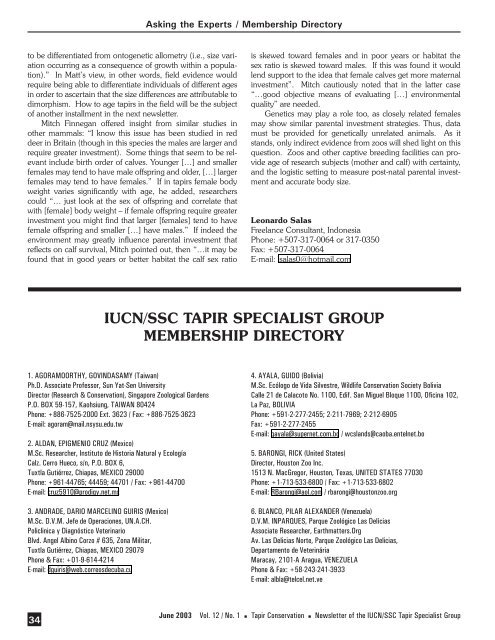Download now - Tapir Specialist Group
Download now - Tapir Specialist Group
Download now - Tapir Specialist Group
You also want an ePaper? Increase the reach of your titles
YUMPU automatically turns print PDFs into web optimized ePapers that Google loves.
to be differentiated from ontogenetic allometry (i.e., size variation<br />
occurring as a consequence of growth within a population).”<br />
In Matt’s view, in other words, field evidence would<br />
require being able to differentiate individuals of different ages<br />
in order to ascertain that the size differences are attributable to<br />
dimorphism. How to age tapirs in the field will be the subject<br />
of another installment in the next newsletter.<br />
Mitch Finnegan offered insight from similar studies in<br />
other mammals: “I k<strong>now</strong> this issue has been studied in red<br />
deer in Britain (though in this species the males are larger and<br />
require greater investment). Some things that seem to be relevant<br />
include birth order of calves. Younger […] and smaller<br />
females may tend to have male offspring and older, […] larger<br />
females may tend to have females.” If in tapirs female body<br />
weight varies significantly with age, he added, researchers<br />
could “… just look at the sex of offspring and correlate that<br />
with [female] body weight – if female offspring require greater<br />
investment you might find that larger [females] tend to have<br />
female offspring and smaller […] have males.” If indeed the<br />
environment may greatly influence parental investment that<br />
reflects on calf survival, Mitch pointed out, then “…it may be<br />
found that in good years or better habitat the calf sex ratio<br />
1. AGORAMOORTHY, GOVINDASAMY (Taiwan)<br />
Ph.D. Associate Professor, Sun Yat-Sen University<br />
Director (Research & Conservation), Singapore Zoological Gardens<br />
P.O. BOX 59-157, Kaohsiung, TAIWAN 80424<br />
Phone: +886-7525-2000 Ext. 3623 / Fax: +886-7525-3623<br />
E-mail: agoram@mail.nsysu.edu.tw<br />
2. ALDAN, EPIGMENIO CRUZ (Mexico)<br />
M.Sc. Researcher, Instituto de Historia Natural y Ecología<br />
Calz. Cerro Hueco, s/n, P.O. BOX 6,<br />
Tuxtla Gutiérrez, Chiapas, MEXICO 29000<br />
Phone: +961-44765; 44459; 44701 / Fax: +961-44700<br />
E-mail: cruz5910@prodigy.net.mx<br />
3. ANDRADE, DARIO MARCELINO GUIRIS (Mexico)<br />
M.Sc. D.V.M. Jefe de Operaciones, UN.A.CH.<br />
Policlinica y Diagnóstico Veterinario<br />
Blvd. Angel Albino Corzo # 635, Zona Militar,<br />
Tuxtla Gutiérrez, Chiapas, MEXICO 29079<br />
Phone & Fax: +01-9-614-4214<br />
E-mail: dguiris@web.correosdecuba.cu<br />
34<br />
Asking the Experts / Membership Directory<br />
is skewed toward females and in poor years or habitat the<br />
sex ratio is skewed toward males. If this was found it would<br />
lend support to the idea that female calves get more maternal<br />
investment”. Mitch cautiously noted that in the latter case<br />
“…good objective means of evaluating […] environmental<br />
quality” are needed.<br />
Genetics may play a role too, as closely related females<br />
may show similar parental investment strategies. Thus, data<br />
must be provided for genetically unrelated animals. As it<br />
stands, only indirect evidence from zoos will shed light on this<br />
question. Zoos and other captive breeding facilities can provide<br />
age of research subjects (mother and calf) with certainty,<br />
and the logistic setting to measure post-natal parental investment<br />
and accurate body size.<br />
Leonardo Salas<br />
Freelance Consultant, Indonesia<br />
Phone: +507-317-0064 or 317-0350<br />
Fax: +507-317-0064<br />
E-mail: lsalas0@hotmail.com<br />
IUCN/SSC TAPIR SPECIALIST GROUP<br />
MEMBERSHIP DIRECTORY<br />
4. AYALA, GUIDO (Bolivia)<br />
M.Sc. Ecólogo de Vida Silvestre, Wildlife Conservation Society Bolivia<br />
Calle 21 de Calacoto No. 1100, Edif. San Miguel Bloque 1100, Oficina 102,<br />
La Paz, BOLIVIA<br />
Phone: +591-2-277-2455; 2-211-7969; 2-212-6905<br />
Fax: +591-2-277-2455<br />
E-mail: gayala@supernet.com.bo / wcslands@caoba.entelnet.bo<br />
5. BARONGI, RICK (United States)<br />
Director, Houston Zoo Inc.<br />
1513 N. MacGregor, Houston, Texas, UNITED STATES 77030<br />
Phone: +1-713-533-6800 / Fax: +1-713-533-6802<br />
E-mail: RBarongi@aol.com / rbarongi@houstonzoo.org<br />
6. BLANCO, PILAR ALEXANDER (Venezuela)<br />
D.V.M. INPARQUES, Parque Zoológico Las Delícias<br />
Associate Researcher, Earthmatters.Org<br />
Av. Las Delicias Norte, Parque Zoológico Las Delicias,<br />
Departamento de Veterinária<br />
Maracay, 2101-A Aragua, VENEZUELA<br />
Phone & Fax: +58-243-241-3933<br />
E-mail: albla@telcel.net.ve<br />
June 2003 Vol. 12 / No. 1 n <strong>Tapir</strong> Conservation n Newsletter of the IUCN/SSC <strong>Tapir</strong> <strong>Specialist</strong> <strong>Group</strong>










